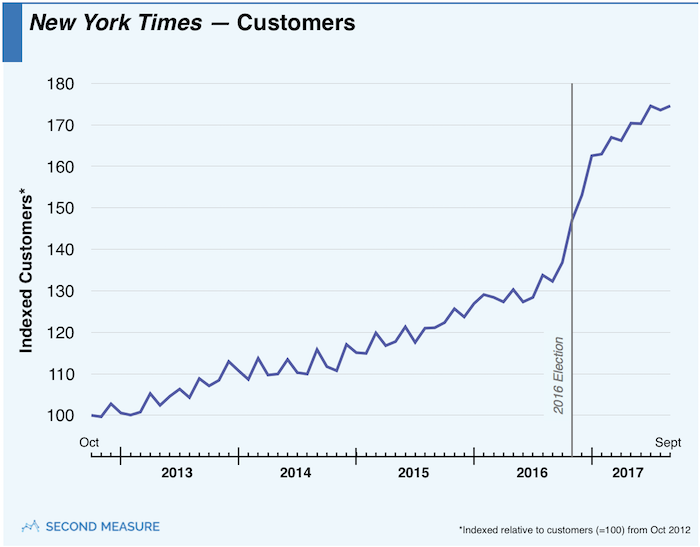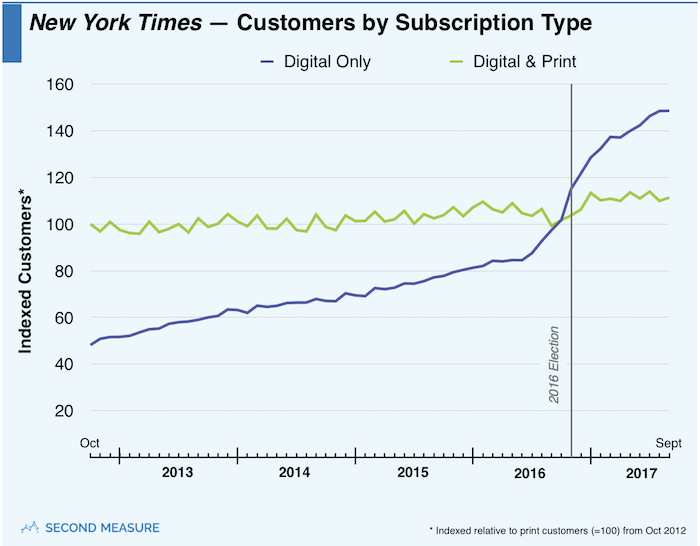NOTE: Bloomberg Second Measure launched a new and exclusive transaction dataset in July 2022. Our data continues to be broadly representative of U.S. consumers. As a result of this panel change, however, we recommend using only the latest posts in assessing metrics, and do not support referring to historical blog posts to infer period-over-period comparisons.
This month marks the one-year anniversary of Donald Trump’s election to the presidency. And, for many Americans, this coincides with another anniversary: it’s been a year since they subscribed to one of the president’s favorite Twitter targets, The New York Times.
The Times reported gaining 41,000 subscribers in the week after last year’s election when many were hungry for updates on the fast-moving news cycle. Others were surprised by Trump’s narrow victory and flocked to support institutions that might hold him accountable. But the subscriber spike at The Times actually began weeks before the election, and we can now see those subscribers have stuck around since.

Most subscriptions are billed monthly, so Times readers have had many opportunities to cancel their plans since the post-election frenzy calmed. (Though, one could argue that this entire year’s news cycle has been anything but calm.) The fact that The Times hasn’t seen a large drop in customers may mean today’s readers really feel—as our ancestors once did—that daily news is worth paying for. The Times’ subscriber growth has continued throughout 2017, though the rate of growth has slowed.
From Debates to Inauguration, Subscribers Grew ‘Bigly’
The “Trump bump,” as many have called it, was concentrated in the last quarter of 2016 and the first quarter of 2017. In other words, it started in the weeks before the election and ended around the time of the Presidential inauguration. The Times (and many other newspapers) offered various subscriber discounts during this time, and this spike in subscriptions was a ‘yuuuuuge’ anomaly.
In the three years before the election (Q4 2013-Q3 2016), subscriber growth averaged just 2 percent per quarter. But in Q4 of 2016, The Times’ customer base grew by a whopping 12 percent. It grew by another 11 percent in Q1 2017. The company’s most recent growth has been more in line with the pre-election baseline: down 1 percent in Q2 and up 2 percent in Q3.
Although the paper hasn’t seen anything like the Trump bump in recent memory, there was a smaller spike around the 2012 election. The Times saw nearly 5-percent growth in Q4 2012. But compared to the 12-percent growth of Q4 2016, it seems last year’s election-season jump was as anomalous as the election itself.
All The News That’s Fit to Print Read Online
The subscription boost wasn’t the only surprising thing The New York Times experienced around the 2016 election. In October 2016—weeks before Election Day—digital-only subscribers surpassed print subscribers for the first time. By September 2017, 57 percent of Times customers bought only the digital version of the paper. (The Times offers an online-only subscription plan but also gives complimentary digital access to print subscribers.)

Digital subscription growth has continued through Q3 of this year, The Times reported in its earnings call this month, and the impressive stats have been the topic of media buzz.
The president may love to Tweet about “the failing New York Times,” but it appears the paper may indirectly have him to thank for a year with a lot of success.
Interested in whether New York Times subscribers will continue to pay for their news? Request a demo today>>
